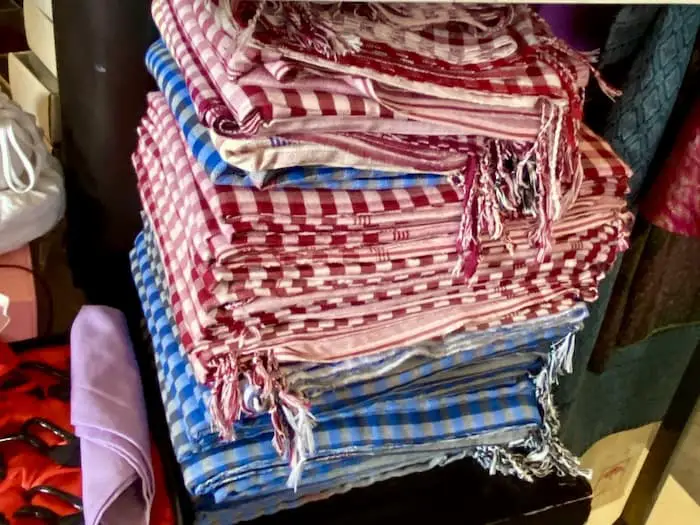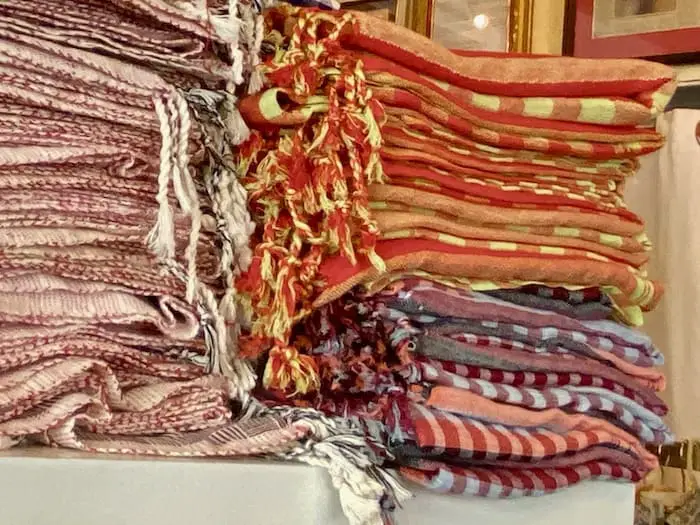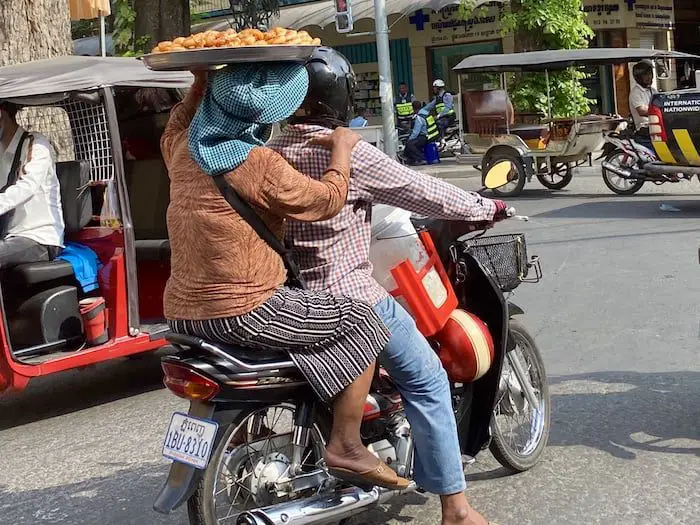Unbeknownst to many, the simple and traditional Cambodian Krama scarf is steeped in history and cultural significance. Woven from cotton – sometimes silk – these brightly colored checkered scarves were initially used for various practical purposes. From covering and protecting the body from dust or personal belongings when working in the fields to being worn around the waist as a skirt during ceremonies, the krama was an integral part of everyday life in Cambodia. The story behind the Cambodian Krama Scarf will take us on an incredible journey through centuries-old tales that showcase resilience amidst times of crisis and strife…
The Cambodian Krama scarf is a gingham scarf used not only as a scarf but also as a bandanna, baby carrier, or even a blanket. Traditionally, each Cambodian would hand-weave their scarf in cotton or silk. Many in the Western world may recognize the red and white gingham scarf that the Khmer Rouge used when they ruled Cambodia. Despite its checkered history, the Khmer Krama scarf symbolizes Cambodian strength, courage, and resilience.
Table of Contents
- Unraveling the History of the Cambodian Krama Scarf: More Than Just a Scarf
- The Krama Scarf – A Checkered Cambodian Symbol
- Related Questions

Unraveling the History of the Cambodian Krama Scarf: More Than Just a Scarf
The Cambodian Krama scarf, often perceived as a simple traditional attire, carries a rich tapestry of history and cultural symbolism.
Crafted primarily from cotton and occasionally silk, these vibrant checkered scarves have played versatile roles in Cambodian life. Initially serving practical purposes like protecting against dust in the fields or being fashioned into a skirt for ceremonies, the Krama has been a staple in daily Cambodian life.
This narrative delves into the profound journey of the Krama, revealing stories of resilience and endurance through periods of turmoil. Not just limited to its use as a scarf, the Krama also functions as a bandanna, baby carrier, or blanket.
Each piece, traditionally hand-woven, tells a story, including the iconic red and white gingham pattern recognized globally from the era of the Khmer Rouge. Despite its tumultuous association, the Krama remains a symbol of the Cambodian spirit of strength, courage, and resilience.
What is the Khmer Krama Scarf?
The Khmer Krama Scarf is a traditional Cambodian scarf with many uses, including a scarf, bandanna, and covering of the face to protect against wind and dust storms. It can also be used for decoration, as a belt when it is wrapped around the waist. Many women may wear it on their heads, especially if they carry things.
It is not just a scarf to protect the Cambodians from the wind or dust; the Cambodians also use the Krama as a makeshift hammock, baby carrier, or headwear to protect against the harsh sun. They may use it as a towel or a wrap after a shower or bath. Or as a blanket to sleep under at night.
The Bokator martial arts, one of the oldest forms of martial arts in Southeast Asia, uses Krama scarves. The fighters will wrap the Krama scarf around their waist, heads, and fists.
The color of the Krama scarf signifies the level and proficiency of the fighter’s martial arts ability and training. A white scarf is for the lowest-level Bokator fighters, and black is for the expert-level fighters.
The Weaving of the Krama Scarf
In Cambodia, most Krama scarves are woven in a checked or gingham pattern. The traditional colors were red and white or blue and white gingham patterns.
Originally, the scarf was a fabric that the Cambodian women would hand-weave on their looms in their own looms. Today, they are still woven by hand, but not everyone will weave their scarf.
These scarves were traditionally woven using these methods:
- The cotton would be spread out to dry and then soaked in rice for 2 or 3 days.
- The Cambodian weavers would use natural dyes to dye the cotton red or blue before weaving.
- The yarns are spun into threads,
- The pattern is woven on the hand looms. a
Cambodia has a very long history of hand-weaving fabrics. It is thought the Cambodians have been hand-weaving since the 13th Century.
To find out more about Cambodia’s hand-weaving, you can read the blog Hand-woven Fabrics from Cambodia, What You Need to Know by clicking here. This blog gives you some insights into Cambodia and its hand-woven fabrics.
Not all Cambodians would weave their Krama scarves in cotton. Many richer Cambodians preferred having their Krama scarves woven in silk.
This is because the silk is much cooler in the hot summer climate and would distinguish the richer Cambodians from the peasants who had the cotton version. It can be said that the Krama scarf would also distinguish the status and wealth of the owner.

The Krama Scarf – A Checkered Cambodian Symbol
During the time of Pol Pot, many of the Khmer Rouge fighters wore red and white gingham Krama scarves. This became a symbol of the brutal Khmer Rouge regime.
On April 17, 1975, thousands of Phnom Penh residents went out onto the streets to cheer the victorious Khmer Rouge troops as they entered the city. The joyous celebration did not last long as they saw the battled hardened and icy stares on the faces of the victorious Khmer Rouge, who were all wearing red and white gingham checkered Krama scarves.
At that time, little did the people of Cambodia know what they would need to endure. It is estimated that from 1975 to 1979, over 2 million Cambodians were murdered, executed, starved to death, or died by disease during the famous “killing fields” era of Cambodian politics.
The red and white gingham Krama scarf became a symbol of the Khmer Rouge. The Khmer Rouge uniform for the soldiers and all the citizens was a pair of black Khmer pajamas, rubber sandals, and the red and white gingham Krama scarf.
This is why the red and white Krama scarf has a bit of a checkered historical past for many Cambodians.
Even today, some Cambodians may refuse to wear a red and white gingham Krama scarf and may opt to wear the blue and white version or another color. This is because of the legacy of the red and white Krama and the Khmer Rouge era of Cambodian politics.
The Krama Scarf Is A Cambodian Symbol of Strength
Despite its checkered past, the Cambodian Krama scarf is more than just a scarf, it is also a symbol of the strength, survival, and courage of the Cambodian people. This fabric has followed the Khmer nation throughout all the good and bad times.
So, it can be said that this Khmer Krama scarf also has its own story of survival. Even in Cambodia today, the Krama scarf remains a significant part of Cambodian life and culture.
The Cambodian Krama scarf is a symbol of Cambodia. When you wear the scarf, you are wearing a Khmer symbol of strength, resilience, and survival.
At A Bus On A Dusty Road, we talk about travel, life, and ex-pat living. We are all about “Living Life As A Global Citizen.” We explore social, cultural, and economic issues and travel.
We would love to have you be part of our community. Sign up for our newsletter to keep up-to-date by clicking here. If you have any questions, you can contact me, Anita, by clicking here.
Listen to our Podcast called Dusty Roads. You can find it on all major podcast platforms. Try out listening to one of our podcasts by clicking here.
Subscribe to our A Bus On A Dusty Road YouTube Channel with great videos and information by clicking here.
Related Questions
Is Cambodia Safe to Travel Alone?
I have traveled alone to Cambodia many times and have always felt safe. But whenever you are traveling alone to any country, especially if you are a woman traveling alone in Cambodia, there are some precautions that you should take.
To find out more about some essential precautions, you can read our blog, Is Cambodia Safe for a Solo Female Traveler to Travel Alone? by clicking here.
Why Should Every Cyclist Ride Around Angkor Wat, Cambodia?
Every cyclist should put cycling around the Angkor Wat temple complexes on their bucket list. Not only is Angkor Wat one of the magnificent architectural wonders of the world, but it is also a great way to see some amazing old temple complexes. When you cycle around Angkor Wat, you will have only the freedom to see it at your own pace, but you will also see things that you could never see in a car, bus or even a tuk-tuk.
To find out some tips and more information on cycling around Angkor Wat or Siem Reap Cambodia, read our blog Why Every Cyclist Should Ride Around Angkor Wat? by clicking here.


